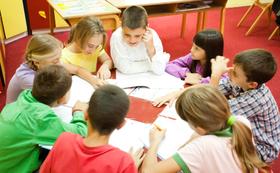Kansas State School for the Blind is a fully accredited public high school located in Kansas City, Kansas, U.S., serving students in grades Pre-K through 12. The school was established in 1867. It is located on 10 acres located in downtown Kansas City, Kansas.
School For Blind High School serves 11 students in grades 7-12.
The percentage of students achieving proficiency in math is <50% (which is higher than the Kansas state average of 31%).
The student-teacher ratio of 2:1 is lower than the Kansas state level of 13:1.
Minority enrollment is 45% of the student body (majority Hispanic), which is higher than the Kansas state average of 39% (majority Hispanic).
Quick Facts (2025-26)
- School Type: Special education school
- Grades: 7-12
- Enrollment: 11 students
- Student-Teacher Ratio: 2:1
- Minority Enrollment: 45%
- Math Proficiency: <50% (Top 20% in KS)
- Source: National Center for Education Statistics (NCES), KS Dept. of Education
Top Rankings
School For Blind High School ranks among the top 20% of public schools in Kansas for:
Category
Attribute
Math Proficiency
Diversity
Community Size
Student Attention
School Overview
School For Blind High School's student population of 11 students has declined by 52% over five school years.
The teacher population of 6 teachers has stayed relatively flat over five school years.
School Type
Grades Offered
Grades 7-12
(No virtual instruction)
(No virtual instruction)
Total Students
11 students
Gender %
Total Classroom Teachers
6 teachers
Year Founded
1867
School Calendar
School Rankings
The diversity score of School For Blind High School is 0.63, which is more than the diversity score at state average of 0.57. The school's diversity has stayed relatively flat over five school years.
Math Test Scores (% Proficient)
<50%
31%
Student-Teacher Ratio
2:1
13:1
American Indian
n/a
1%
Asian
n/a
3%
Hispanic
18%
22%
Black
9%
7%
White
55%
61%
Hawaiian
n/a
n/a
Two or more races
18%
6%
All Ethnic Groups
Participates in the National School Lunch Program (NSLP)
Yes
Eligible for Free Lunch
27%
41%
Eligible for Reduced Lunch
27%
7%
School Statewide Testing
School District Name
Source: National Center for Education Statistics (NCES), KS Dept. of Education
School Notes
- School Mascot: Eagle
Profile last updated: 02/09/2025
Frequently Asked Questions
How many students attend School For Blind High School?
11 students attend School For Blind High School.
What is the racial composition of the student body?
55% of School For Blind High School students are White, 18% of students are Hispanic, 18% of students are Two or more races, and 9% of students are Black.
What is the student-teacher ratio of School For Blind High School?
School For Blind High School has a student ration of 2:1, which is lower than the Kansas state average of 13:1.
What grades does School For Blind High School offer ?
School For Blind High School offers enrollment in grades 7-12 (No virtual instruction).
What school district is School For Blind High School part of?
School For Blind High School is part of School For Blind School District.
In what neighborhood is School For Blind High School located?
School For Blind High School is located in the Riverview neighborhood of Kansas City, KS. There are 5 other public schools located in Riverview.
School Reviews
Review School For Blind High School. Reviews should be a few sentences in length. Please include any comments on:
- Quality of academic programs, teachers, and facilities
- Availability of music, art, sports and other extracurricular activities
Recent Articles

Texas Schools Enrollment Trends & Policy in 2025
Latest data and policy changes on Texas public school enrollment growth, funding, and virtual education in 2025.

Financial Aid & Hidden Costs in ╬█╬█┬■╗ş Schools
Learn about financial aid and hidden costs in public schools. Discover what parents should budget for beyond tuition-free education.

NYC Schools Still Most Segregated in 2025
Despite reforms, New York City schools remain the most segregated in the U.S. in 2025. HereÔÇÖs what parents and educators need to know.





